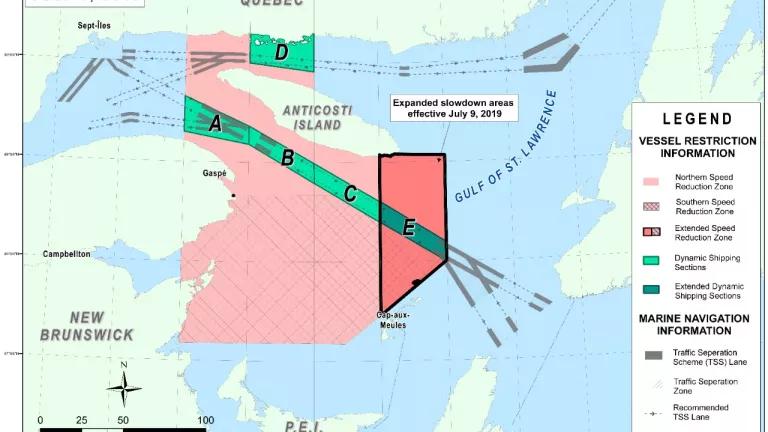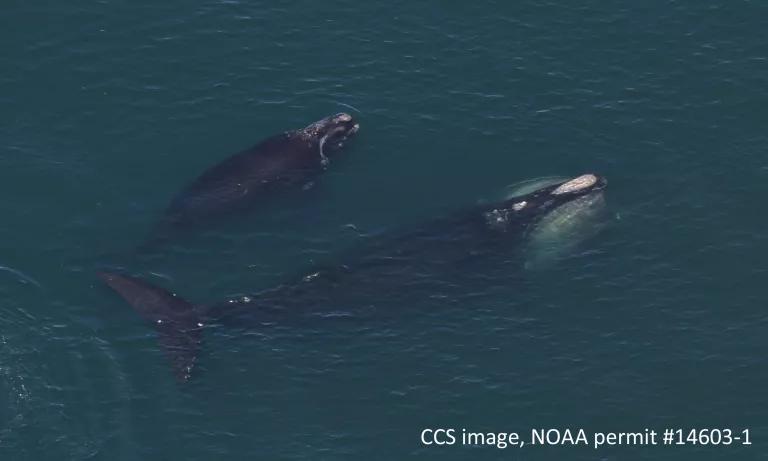
Canada has strengthened protections for North Atlantic right whales following the spate of deaths last month. The Department of Fisheries and Oceans Canada and Transport Canada announced yesterday that it will:
- Increase surveillance effort to spot whales and trigger protective measures before they fall into harm’s way. Canada has essentially tripled the number of aerial surveys its agencies are conducting. This more intense degree of surveillance will continue until at least July 15 and the results will be used to determine the plan for increased surveillance for the rest of the season, as well as further measures required to protect the whales.
- Expand mandatory vessel speed restrictions further east to cover an area where whales have been sighted and at least one has likely been struck by a vessel (see Figure 1). This includes an expansion of the current slowdown zone where vessels are required to travel at 10 knots throughout the season, and a new slowdown shipping lane where vessels will be required to slow down to 10 knots when a North Atlantic right whale is spotted in the area. Vessels traveling at 10 knots or less are less likely to cause serious injury or mortality if they hit a whale, and may be more able to avoid an encounter altogether.
- Expand mandatory speed restrictions to smaller vessels to reduce the likelihood that serious injury or mortality results from a vessel collision. Previously, mandatory speed restrictions were only put in place for vessels 20 meters (65 feet) or longer. Now vessels of 13 meters (42 feet) or longer will be required to travel at 10 knots. Studies have shown that vessels of virtually any length have the potential to cause serious injury or mortality of right whales if they are traveling above 10 knots. Expanding vessel speed restrictions to smaller vessels will offer greater protection from vessel collisions.
- Adjust the trigger for fisheries closures to protect right whales from entanglement. If one or more right whales are observed anywhere in the Gulf of St Lawrence any non-tended fixed-gear fisheries in the area of the sighting will close for 15 days.
Additional measures also mean that temporary suspension of the vessel speed restrictions for safety reasons due to inclement weather will now affect a smaller geographic area and, once the interim slowdown is lifted in the shipping lanes, the buffer zone around shipping lanes will be expanded from 2.5 to 5 nautical miles. If a right whale is spotted in the buffer zone, the speed restrictions within the shipping lane will be triggered.
Canada also announced that it will provide $5 million (CAN) in new funding over the next four years towards six projects to help safeguard right whales, and will also fund two additional projects to mitigate risks and support conservation.
The full announcement describing the new measures can be found here.
The new measures could not have come soon enough. Six North Atlantic right whales have been found dead this year all in Canadian waters and four of those were found within a single 48-hour period in June. Evidence indicates that three whales died from blunt force trauma consistent with a vessel strike. This is a catastrophic loss for a species comprising few more than 400 whales and casts a dark cloud over the joyful news of seven new calves just a few months ago.
Perhaps even more devastating is that the losses include four females of or almost breeding age. With their deaths we have also lost all the calves that they may have given birth to in the future. Breeding females are the lifeblood of a species; without them, the North Atlantic right whale has little hope of survival. There are estimated to be fewer than 100 breeding females surviving in the entire species.

Following the worrying number of deaths in June, NRDC joined forces with our NGO allies in the U.S. to send a letter calling on the Prime Minister of Canada, the Minister of Fisheries and Oceans Canada, and the Minister of Transport Canada to implement immediate and longer-term conservation measures to protect the North Atlantic right whale.
You can view the U.S. NGO letter here.
Many of Canada’s strengthened measures align with our recommendations, including the expansion of the mandatory vessel speed restrictions and the significant expansion of visual and acoustic survey efforts to detect right whales (both living and dead) throughout the Gulf. During the initial media advisory on Canada’s new measures, Sylvie Lapointe, the Assistant Deputy Minister for Fisheries, cited the U.S. NGO letter as being influential in developing their response.
However, there remain some concerning gaps in Canada’s new measures. The increased surveillance efforts are currently only planned through July 15 and will then be reevaluated. Right whales have been sighted in the Gulf of St Lawrence through November and intensive monitoring and vessel speed restrictions should be in place throughout this time. Passive acoustic monitoring is also needed in addition to aerial surveys to maximize the probability of right whale detection.
In addition, the mandatory vessel speed restriction zone only covers a small proportion of the Gulf of St Lawrence even though right whales may be at risk across the entire area. How effectively the vessel speed restrictions will be enforced is also still an open question. Transport Canada has reported 111 violations of existing speed restrictions, nine of which remain under review, but so far no fines have been issued.
Entanglement in fishing gear is also still a serious issue. Three entangled whales have been spotted in the Gulf of St Lawrence within the last two weeks. They have been sighted in areas already closed to fishing, meaning that they carried the gear with them either from other fishing areas in Canada or the U.S. Both countries need to reduce risk of entanglement in fishing gear, including by working towards innovative solutions like ropeless fishing systems that will protect right whales and keep fishermen on the water.
This is the time we need to fight even harder to protect our right whales. Canada’s response demonstrates the positive affect we can have when we make our collective voices heard. We must keep working to ensure the strongest possible protective measures are in place both in Canada and the U.S.
Join our fight to protect North Atlantic right whales.


